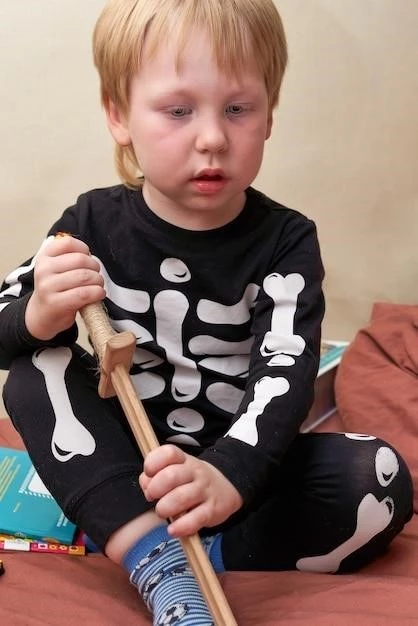Understanding Graham–Boyle–Troxell Syndrome
Graham–Boyle–Troxell Syndrome is a rare genetic disorder characterized by inherited neurological symptoms, developmental delays, intellectual disability, and speech impairments․ This article aims to provide insights into the causes, diagnosis, treatment options, and supportive care for individuals with chromosome 3q duplication․
Overview of Graham–Boyle–Troxell Syndrome

Graham–Boyle–Troxell Syndrome, also known as chromosome 3q duplication syndrome, is a rare genetic disorder that presents with a constellation of neurological symptoms․ Individuals affected by this syndrome often experience developmental delays, intellectual disability, and speech impairments․ The syndrome is caused by the duplication of genetic material on the long arm (q) of chromosome 3․
Common characteristics of Graham–Boyle–Troxell Syndrome include distinctive facial features, such as a broad forehead, wide-set eyes, and a prominent nose․ Patients may also exhibit hypotonia, feeding difficulties, and seizures․ The severity of symptoms can vary widely among affected individuals, ranging from mild to profound developmental challenges․
Due to the rarity of this syndrome, diagnosis can be challenging and may require genetic testing to confirm the presence of chromosome 3q duplication․ Early intervention and holistic care are crucial for managing the symptoms and maximizing the quality of life for individuals living with Graham–Boyle–Troxell Syndrome․
Symptoms and Effects
Individuals with Graham–Boyle–Troxell Syndrome may exhibit a wide range of symptoms and effects that impact various aspects of their development and daily life․ Common symptoms include neurological challenges such as hypotonia (low muscle tone), feeding difficulties, seizures, and sleep disturbances․ Intellectual disability and speech impairments are also prevalent, affecting communication and cognitive abilities․
Physical characteristics often associated with the syndrome include distinctive facial features like a broad forehead, wide-set eyes, and a prominent nose․ Some individuals may experience vision or hearing impairments, gastrointestinal issues, and musculoskeletal abnormalities․ Behavioral challenges, such as hyperactivity, anxiety, and repetitive movements, can also be present in affected individuals․
The effects of Graham–Boyle–Troxell Syndrome can vary in severity from person to person, impacting overall development, social interactions, and independence․ Early identification of symptoms and a multidisciplinary approach to care are vital for addressing the complex needs of individuals with this rare genetic disorder․
Causes and Genetic Basis
Graham–Boyle–Troxell Syndrome is primarily caused by the duplication of genetic material on the long arm (q) of chromosome 3․ This duplication leads to an excess of specific genes or genetic segments, disrupting normal development and function․ The exact mechanism through which chromosome 3q duplication results in the characteristic symptoms of the syndrome is not fully understood․
The duplication of genetic material can occur sporadically or may be inherited from a parent who carries the chromosomal abnormality․ In cases where the syndrome is inherited, it follows an autosomal dominant pattern, meaning that a single copy of the abnormal gene in each cell is sufficient to cause the disorder․
Research into the specific genes and pathways affected by chromosome 3q duplication in Graham–Boyle–Troxell Syndrome is ongoing, aiming to elucidate the molecular mechanisms underlying the condition․ Understanding the genetic basis of the syndrome is essential for developing targeted treatment approaches and improving outcomes for affected individuals․
Diagnosis and Genetic Testing
Diagnosing Graham–Boyle–Troxell Syndrome can be complex and often necessitates a combination of clinical evaluation, genetic testing, and specialized imaging studies․ A thorough physical examination may reveal characteristic facial features and other physical abnormalities associated with the syndrome․
Genetic testing, such as chromosomal microarray analysis or fluorescence in situ hybridization (FISH), is crucial for confirming the presence of chromosome 3q duplication․ These tests can identify specific genetic abnormalities and provide definitive evidence of the underlying cause of the individual’s symptoms․
In some cases, prenatal testing may be recommended for families with a history of Graham–Boyle–Troxell Syndrome or known chromosomal rearrangements․ Early diagnosis through genetic testing enables healthcare providers to offer appropriate interventions, support services, and family counseling tailored to the specific needs of individuals with this rare genetic disorder․
Treatment Options
Currently, there is no specific cure for Graham–Boyle–Troxell Syndrome, as it is a genetic disorder․ However, various treatment options focus on managing symptoms, enhancing quality of life, and providing comprehensive care for affected individuals․ Early intervention programs that address developmental delays, cognitive deficits, and speech impairments can significantly benefit patients․
Individualized therapies, such as occupational therapy, physical therapy, and speech therapy, play a crucial role in supporting the overall development and functional abilities of individuals with the syndrome․ Behavioral interventions and educational support can also help address learning challenges and promote social skills․
Seizures associated with Graham–Boyle–Troxell Syndrome may require anti-seizure medications for management․ Regular monitoring by a multidisciplinary healthcare team is essential to assess the effectiveness of treatment strategies and adjust interventions as needed․ Genetic counseling can provide families with essential information about the genetic basis of the syndrome and facilitate informed decision-making․
Supportive Care and Future Outlook
Supportive care plays a critical role in enhancing the quality of life for individuals with Graham–Boyle–Troxell Syndrome․ This includes ongoing medical monitoring, early intervention services, and access to specialists such as neurologists, developmental pediatricians, and genetic counselors․ Supportive therapies aimed at improving communication, motor skills, and social interactions can aid in maximizing the potential of individuals affected by the syndrome․
Emotional support for families and caregivers is essential, as managing the complex needs of individuals with rare genetic disorders can be challenging․ Peer support groups and community resources can offer valuable assistance and a sense of belonging to those impacted by Graham–Boyle–Troxell Syndrome․
While there is no definitive cure for the syndrome, advances in genetic research and medical therapies hold promise for the future․ Continued research into the genetic basis of Graham–Boyle–Troxell Syndrome may lead to the development of targeted treatment approaches and improved diagnostic techniques․ By advocating for increased awareness and understanding of rare diseases, we can foster a more inclusive and supportive environment for individuals and families affected by this complex genetic condition․
